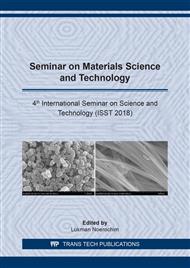[1]
N. Miura, M. Ono, K. Shimanoe, N. Yamazoe, A Compact Amperometric NO2 Sensor Based On Naþ Conductive Solid Electrolyte, J.Appl .Electrochem. 28 (1998) 863–865.
Google Scholar
[2]
S. Zhang, B. Quan, Z. Zhao, B. Zhao,Y .He, W. Chen, Preparation And Characterization Of NASICON With Anewsol-Gelprocess, Mater. Lett. 58 (2003) 226–229.
Google Scholar
[3]
T. Kida, N. Morinaga, S. Kishi, K. M. An, K. W. Sim, B. Y. Chae, J.K. Kim B.K. Ryu, Electrochemical Detection Of Volatile Organic Compounds Using A Na3Zr2Si2PO12/Bi2Cu0.1V0.9O5.35 Hetero Junction Device, Electrochim.Acta 56 (2011)7484–7490.
DOI: 10.1016/j.electacta.2011.06.108
Google Scholar
[4]
Y.L. Ding, R.N. Forster J.P.K. Seville D.J. Parker, Some As Pectsof Heat Transfer In Rolling Mode Rotating Drums Operated At Low To Medium Temperatures, Powder Technol. 121 (2001) 168–181.
DOI: 10.1016/s0032-5910(01)00343-6
Google Scholar
[5]
Ling Wang, Huizhu Zhou, KuiLiu, Yinlin Wu, Lei Dai, R.V. Kumar, A CO2 Gas Sensor Based Upon Composite Nasicon/Sr-Β-Al2O3 Bielectrolyte, Solid State Ion. 179 (2008) 1662–1665.
DOI: 10.1016/j.ssi.2008.02.045
Google Scholar
[6]
P. Porkodi, V. Yegnaraman, P. Kamaraj, V. Kalyanayallj, D. Jeyakumar, Synthesis Of NASICON-Amolecular Precursor- Based Approach, Chem. Mater. 20 (2008) 6410–6419.
DOI: 10.1021/cm800208k
Google Scholar
[7]
J.W. Fergus, Ion Transport in Sodium Ion Conducting Solid Electrolytes, Solid StateIon. 227(2012)102–112.
DOI: 10.1016/j.ssi.2012.09.019
Google Scholar
[8]
P. Yadav, M. C. Bhatnagar, Structurals Tudies Of NASICON Material of Different Compositions Bysol–Gel Method, Ceram. Int. 38 (2012) 1731–1735.
DOI: 10.1016/j.ceramint.2011.09.022
Google Scholar
[9]
L. Wang, R.V. Kumar, A New SO2 Gas Sensor Based On An Mg2+ Conducting Solid Electrolyte, J.Electroanal. Chem. 543 (2003) 109–114.
DOI: 10.1016/s0022-0728(02)01438-9
Google Scholar
[10]
A.B. Yaroslavtsev, I. A. Stenina, Complex Phosphates with The NASICON Structure (Mx A2-(PO4)3), Rus. J. Inorg.Chem.51(2006) S97–S116.
DOI: 10.1134/s0036023606130043
Google Scholar
[11]
R.O. Fuentes, F.M. Figueiredo, F. M. B .M.arques, J.I. Franco, Processing And Electrical Properties Of NASICON Prepared From Yttria Doped Zirconia Precursors, J.Eur.Ceram.Soc.21(2001)737–743.
DOI: 10.1016/s0955-2219(00)00264-8
Google Scholar
[12]
P. Yadav, M.C. Bhatnagar, Preparation, Structure and Conductivity of Sn Modified NASICON Material, J. Electroceram. 30 (2013) 145–151.
DOI: 10.1007/s10832-012-9776-6
Google Scholar
[13]
E.M. Vogel, Na+ Ion Conductivity and Crystallographic Cell Characterization in The Hf-Nasicon System Na1+XHf2PxP3-XO12, Solid State Ion. 14 (1984) 1–6.
DOI: 10.1016/0167-2738(84)90002-x
Google Scholar
[14]
W. Wang, Z. Zhang, O. U. Xiangyang, J. Zhao, Properties and Phase Relationship of The Na1+XHf2-YTiySixP3-xO12 System, Solid State Ion. 28–30 (1988) 442–445.
DOI: 10.1016/s0167-2738(88)80080-8
Google Scholar
[15]
Bingxing Xie, Danyu Jiang, Jian Wu, Tao Feng, Jinfeng Xia, Hongqiang Nian, Effect Of Substituting Ce For Zr On The Electrical Properties Of Nasicon Materials, Journal of Physics and Chemistry of Solids 88 (2016) 104-108.
DOI: 10.1016/j.jpcs.2015.10.003
Google Scholar
[16]
Eric D. Wachsman, Palitha Jayaweera, Gopala Krishnan, Angel Sanjurjo, Electrocatalytic Reduction Of NOx On La1−xAxB1−yB'yO3−δ: Evidence Of Electrically Enhanced Activity, Solid State Ionics. 136-137 (2000) 775-782.
DOI: 10.1016/s0167-2738(00)00548-8
Google Scholar
[17]
H. Perthuis, Ph. Colombant, Sol–Gel Routes Leading to NASICON Ceramics, Ceram. Int. 12 (1986) 39–52.
DOI: 10.1016/s0272-8842(86)80008-6
Google Scholar
[18]
V.M. Pratiwi. H. Purwaningsih, R. Fajarin, H. Setyawan, The Effects of the Addition of Silica Mol Fraction (x= 1.5; 2; 2.5) as a Solid Electrolyte on Ion Conductivity of NASICON (Na1-xZr2SixP3-xO12) Using Solid-State Method, IOP Conference Series: Materials Science and Engineering 202 (1), 012083.
DOI: 10.1088/1757-899x/202/1/012083
Google Scholar
[19]
Grzegorz Paściak et. al (2014) Structure and Electrical Studies of NASICON Material for NOx Sensing. Cer. International 40 (2014) 12783-12787.
DOI: 10.1016/j.ceramint.2014.04.132
Google Scholar


